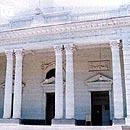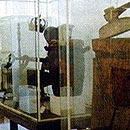The Bacardi Museum
This is no doubt one of the oldest and most talked-about museums in Cuba, one of the first ones ever founded regarding its grand opening in 1899, and second only to the museum opened in Havana back in 1874 under the sponsorship of the Royal Academy of Medical, Physical and Natural Sciences, and the Museum of Natural History pieced together with the collections of Cuba's well-known ichthyologist Felipe Poey. But despite being the longstanding runner-up in this category nationwide, the Bacardi Museum was the first such public facility ever founded on the island nation and one of the most important of all due to the collections it treasures.
His founder was no other than Santiago's politician and writer Emilio Bacardi Moreau. Born in 1844 in a household of famed and well-heeled Catalonian industrials, his independence zeal threw him in jail in Chafarinas and Ceuta. As a writer, he excelled in storytelling with Via Cruces and Doña Guiomar, while his career as a historian is marked by the writing of the three essential volumes of Chronicles of Santiago de Cuba. He was the city's first mayor following the end of the Spanish colonial rule in 1898. From that office that he won by popular vote in 1901, he boosted up welfare works and embarked on a sturdy cultural crusade that eventually came true with the foundation of the Municipal Academy of Fine Arts, the city's library and the museum that was named after him when he passed away in 1922. The Lottery List Don Emilio's original idea behind the foundation of the museum was essentially the preservation of relics hailing from Cuba's independence wars in a city that has deservedly been dubbed “The Capital of History.” Shortly after that and still stressing on its initial purpose, the museum turned into a more general institution. Its vast collections of documents and testimonies dealing with the history of Santiago de Cuba and the island nation were soon joined by samples of ethnology, ancient culture and paintings. In this particular respect, the Bacardi Museum's collection of colonial painting is by far one of the country's largest and most picturesque of all, featuring portraits, huge groceries and landscapes created by the most outstanding artists at the time.
The building housing the museum on the corner of Pio Rosado and Aguilera streets opened its gates in 1928. The eclectic-style edifice stands for one of the most unwavering instances of Santiago de Cuba's republican architecture. Its three stories take visitors on a grand tour all around Cuba from the pre-Hispanic times –with priceless collections of the aboriginals' material legacy- and the Spanish colonization all the way to the independence struggle and the Spanish-American War. Out of that dog-eared page of Cuba's history, the museum showcases the makeshift torpedo built by Cuban freedom fighters to blow up Spanish gunship at the mouth of the Cauto River.
European arts and South American civilizations also flaunt their roots at the Bacardi. The museum shows off a couple of 1,000-plus-year-old Peruvian mummies from the old-time Paraca people. They belong to a man and a woman who were spontaneously mummified by the combination of extreme air dryness and nitrous substances found in the sandy strips where the twosome was buried.
Another mummy –this one from Egypt- decked out with all its attributes looks remarkably well preserved despite its 4,000 years old. This one belongs to a young woman from the 18th Dynasty at a time when Thebes was the Egyptian capital circa 2,000 years BC. Emilio Bacardi traveled to that northern African nation in the flesh to buy the mummy in Luxor.
An in-depth tour around the Bacardi Museum goes beyond both the goals and editing boundaries of this article. Just a handful of details are enclosed because it's much better for visitors to drop in and go unearthing things little by little with their very eyes.
However, this recount cannot fail to mention an oleo that will surely catch the visitor's watchful attention. The Lottery List was authored by Santiago-born Jose Joaquin Tejeda (1867-1943), a highly sensitive and landscape-oriented painter who sowed the seeds of success and good ratings at the time. Even Jose Marti once wrote a chronicle full of admiration after watching a sample of his works in New York City.
Scores of copies have been printed out since then and visitors won't wonder why. The oleo portrays a typical street scene in which people from all walks of life –as their garments give them away- lean to a lottery list to know the winning number while at the same time a completely unresponsive Chinaman pushes his wheelbarrow past the group.
A visit to the Bacardi Museum in Santiago de Cuba should not rule out a peek at the building's colonial patios, nor the life-sized facades of some of the city's most emblematic houses ingrained in an cutout alley.
Bread out of stones Facundo Bacardi Mazo was Emilio's father. He was born in Sitges and landed on Santiago de Cuba at a time when people said that he who owned no lands in Catalonia did have relatives in Cuba. Here he married Lucia Moreau, the daughter of a French-Haitian émigré and a captain of the Napoleonic army. After tripping on a few snags along the way, Facundo set up the distillery where he started brewing the now famous Bacardi rum. Don Emilio ran the rum factory after his father's death.
Facundo Bacardi was said to utter in a whisper every once in a while: Els catalans de les pedres fan pans. His son Emilio also churned out bread out of stones and, among many other things, furthered this Cuban museum named after him that for the past 100 years has accounted for one of the heftiest cultural choices the city of Santiago de Cuba has to offer.
Heritage values:
- Personal belongings of Jose Marti, Antonio Maceo and Carlos Manuel de Cespedes. - An Egyptian mummy brought to the museum by Emilio Bacardi. - The best painting collection of Cuban classics.
Museum activities:
- The Lyrical Corner: second Saturday of every month featuring performers from Santiago de Cuba at the museum's entrance hall. - Balconies, Sunsets and Serenades chat room held at the museum's patio the third Saturday of every month at 3:00 pm.
Visiting hours: Tuesday through Saturday from 9:00 am to 9:00 pm Sunday from 9:00 am to 1:00 pm Monday from noon to 9:00 pm
Mailing address: Carniceria on the corner of Aguilera. Phone: (5322) 628402




































































